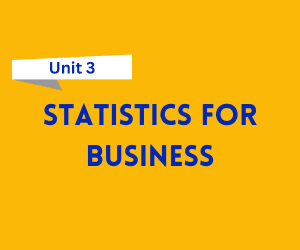In business decision-making, it is often necessary to summarize large sets of data to understand overall trends or patterns. This is where measures of central tendency and dispersion come into play. While central tendency tells us the average or “typical” value of a dataset, dispersion explains how much the values deviate or spread out from that average. Together, they provide a comprehensive picture of data behavior, which is essential for making informed business judgments.

Download Unit 3 – Measures of Central Tendency and Dispersion Notes
Get simplified revision notes for this unit:
Download Unit 3 Notes PDF
Measures of Central Tendency
Central tendency refers to the central value or average of a dataset. The main types are mean, median, and mode, each useful in different contexts.
Mean
The mean is the arithmetic average and is calculated by dividing the sum of all observations by the number of observations. It is widely used due to its simplicity and mathematical properties.
Arithmetic Mean: Most common form used in calculating average sales, expenses, etc.
Geometric Mean: Useful in calculating average growth rates or returns over time.
Harmonic Mean: Applied when dealing with rates, such as speed or efficiency.
Merits: Easy to calculate, considers all values, widely accepted.
Demerits: Sensitive to extreme values (outliers), not suitable for skewed data.
Median
The median is the middle value in an ordered dataset. If the number of observations is even, it is the average of the two middle values.
Merits: Not affected by extreme values, better for skewed distributions (like income data).
Demerits: Doesn’t consider all data values, less useful for complex calculations.
Mode
The mode is the value that appears most frequently in a dataset. It is useful for categorical data or identifying popular choices.
Merits: Easy to understand, useful for non-numeric data.
Demerits: May not exist or may be multiple, not mathematically stable.
Measures of Dispersion
While central tendency tells us where the center lies, dispersion measures tell us how spread out the data is around that center. These are essential in risk analysis, quality control, and performance measurement.
Range
The range is the difference between the highest and lowest values in a dataset.
Simple to compute, but heavily affected by outliers and ignores intermediate values.
Quartile Deviation (Interquartile Range)
This measures the spread of the middle 50% of data (between the first and third quartiles). It is more resistant to outliers and gives a better sense of spread in skewed distributions.
Mean Deviation
Mean deviation is the average of the absolute differences from the mean.
It shows how much, on average, each value deviates from the mean.
Standard Deviation (SD)
The standard deviation is the most widely used measure of dispersion. It is the square root of the average squared deviations from the mean. A low SD indicates that the data points are close to the mean, while a high SD indicates greater spread.
Importance in Business: Helps in risk management, inventory control, and investment analysis by assessing variability in returns, sales, or costs.
Coefficient of Variation (CV)
The coefficient of variation is the ratio of standard deviation to the mean, expressed as a percentage. It is especially useful in comparing variability across datasets with different units or means.
For example, comparing profitability of two business units with different average earnings becomes easier with CV, as it standardizes the level of risk relative to return.
Applications in Business
Understanding measures of central tendency and dispersion helps in:
Setting realistic sales or profit targets
Evaluating performance across different departments
Analyzing employee productivity or customer preferences
Assessing risk and variability in investment options
Making comparisons across time periods, regions, or product categories
